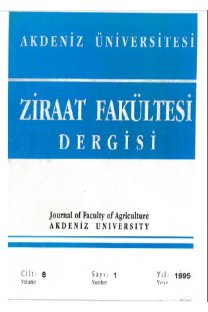Farklı yetiştirme ortamlarının sera ve iklim odası koşullarında patates (Solunum tuberosum L.) mini yumru üretimine etkileri
Bu araştırmada, Concorde, Granola, Marabel, Marfona ve Velox patates çeşitlerine ait tek boğum eksplantlarından geliştirilen in vitro fideler materyal olarak kullanılmıştır. Araştırmanın amacı iârkh yetiştirme ortamlarının (torfiperlit karışımı, 1.5:1, 2:1 ve 3: 1) sera ve iklim odası koşullarında mini yumru üretimine etkilerini belirlemek olmuştur. Bitki boyu, bitkide sap ve yaprak sayısı, ana sapta boğum sayısı, bitkide mini yumru sayısı ve ağırlığı ve ortalama mini yumru ağırlığı gibi bitki ve yumru özellikleri ölçülmüştür. Tüm özelliklerde iklim odası koşullarında sera koşullarına göre daha yüksek değerler bulunmuştur. En yüksek bitkide mini yumru sayısı ve ağırlığı sera koşullarında Marabel (6.33 ve 47.77g), iklim odası koşullarında ise Granola (7.78 ve 54.67g) çeşidinde saptanmıştır. Araştırma sonuçlarına göre mini yumru üretiminde yetiştirme ortamı olarak 2:1 ve 3:1 torftperlit karışımı kullanılabilir.
Anahtar Kelimeler:
Solanum tuberosum, bitki yetiştirme sistemleri, büyüme ortamı, in vitro kültür, patates, verim
The effects of different growing mediums on minituber production of potato (Solunum tuberosum L.) in greenhouse and climate room conditions
In this research, in vitro transplants developed from single node explants of Concorde, Granola, Marabel, Marfona and Velox potato cultivars were used as a material. The aim of the research was to determine the effects of different growing mediums (peat:perlit mixture, 1.5:1, 2:1 and 3:1) on the production of minituber in greenhouse and climate room conditions. The plant and tuber traits such as plant height, stem and leaf number per plant, node number per main stem, minituber number and weight per plant and average minituber weight were measured.The values for all traits were higher in climate room than greenhouse grown plants. The highest minituber number and minituber weight per plant were obtained from Marabel (6.33 and 47.77 g) in greenhouse condition and Granola (7.78 and 54.67g) in climate room condition. According to the results of this research, 2:1 and 3:1 peat: perlit mixture can be used as a growing medium for minituber production.
Keywords:
Solanum tuberosum, cropping systems, growing media, in vitro culture, potatoes, yields,
___
- Freed, R., Einensmith, S.P., Guetz, S., Reicosky, D., Smail. V.W., Wolberg, P., 1989. User' s Guide to MSTAT-C Analysis of Agronomic Research Experiments, Michigan State Uni. USA.
- Grigoriadou, K. And Leventakis N., 1999. Large Scale Commercial Production of Potato Minitubers, Using In Vitro Techniques. Potato Research, 42, (3-4), 607-610.
- Kaur, J., U. Pamar, R. Gill, A.S. Sindhu and Gosal, S.S., 2000. Efficient Method for Micropropagation of Potato through Minituber Production. Indian Journal of Plant Physiology, 5 (2):163-I67.
- Murashige, T., F., Skoog, 1962. A Revised Medium for Rapid Growth and Bioassay with Tobacco Tissue Cultures. Physiol. Plant., 15:473-497.
- Seabrook, J.E.A., Percy, J.E., Douglass, K.L. and Tai, G.C.C., 1995. Photoperiod In Vitro Affect Subsequent Yield of Greenhouse Grown Potato Tuber. Amer. Potato Journal, 72: 365-373.
- Solis, S. F., 1998. Production of Basic Seed Minitubers of Potato: IN. Evaluation of Growing Media for Growing Microplants. Proceedings of The Interamerican Society for Tropical Horticulture, 41:36-38.
- Yıldırım, Z., 2002. Meristem Kültürü Yoluyla Mini Yumru Elde Edilmesi. III. Ulusal Patates Kongresi, 23-27 Eylül 2002, Bornova-tzmir, 93-97.
- Yurtsever, N., 1984. Deneysel İstatistik Metodları. Tarım Orman ve Köy İşleri Bakanlığı, Toprak ve Gübre Araştırma Enstitüsü Müdürlüğü Yayınları, 121.
- ISSN: 1301-2215
- Yayın Aralığı: Yılda 2 Sayı
- Başlangıç: 1983
- Yayıncı: Akdeniz Üniv. Ziraat Fak.
Sayıdaki Diğer Makaleler
İlknur Korkutal, DEMİR KÖK, ELMAN BAHAR, Cem SARIKAYA
